
We are celebrating 15 years — and counting — of stories that are deeply researched and deeply felt, that build a historical record of what the city has been.
We are celebrating 15 years — and counting — of stories that are deeply researched and deeply felt, that build a historical record of what the city has been.
The popular conception of New York City can often obscure the wild places within its reaches. But as the presence of an urban field station created in part by the US Forest Service might signal, they do exist, tucked within our parkland and enjoyed by many. In one of Urban Omnibus’ earliest features back in 2009, we sat down with Lindsay Campbell and Erika Svendsen, respectively a human geographer and social scientist based at the field station, to hear about their research into all variety of stewardship groups — the block association to the trail maintenance crew — that care for New York City in both its stereotypically urban and wild iterations. While this work continues, having now spread to six cities across the US, Campbell and Svendsen have also been busy partners in a massive ecological and social assessment of its natural areas.
Incubated by a partnership between the New York City Parks Department, the nascent Natural Areas Conservancy, and the Forest Service, the assessment not only looks into the state of the city’s wilder parkland in terms of native versus invasive species and soil quality; it also seeks hard-won evidence for the role these areas play in the lives of New Yorkers. Now with more data in hand than has ever been gathered in a city, the triumvirate looks to transform it into a long-term plan for managing these spaces for the benefit of plants and (human) animals alike. Becca Cudmore reports on how New Yorkers connect with natural areas, how our urban forests are faring, and how that baseline information is put to action in determining the very nature of our parks. –J.T.
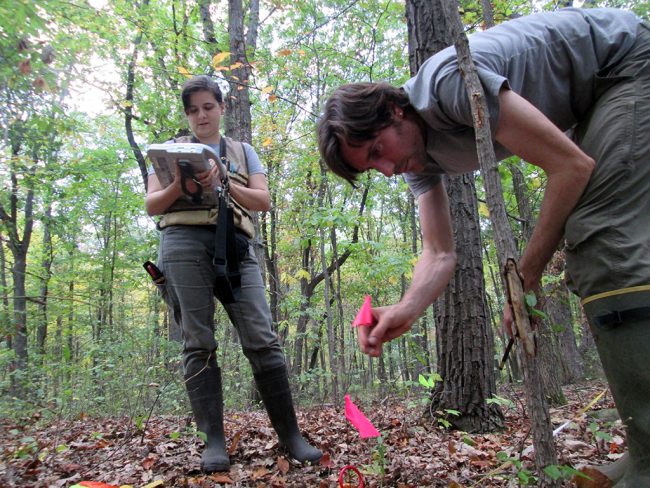
Researchers assess the ecological health of a forest in Staten Island | Photo courtesy of Natural Areas Conservancy
The Civil War prime of Fort Totten, a former military fortress in Bayside, Queens, is long past. But in many ways, the complex has gained a second life: about 30 years ago, the federal Department of Defense handed Totten over to New York City for parkland. The switch attracted a diversity of new tenants. Feral cats and raccoons now fill empty barracks. A restored army officers’ clubhouse houses the local historical society, and a few buildings over, New York’s police and fire departments train the city’s next finest and bravest, canines included. Families come for the old parade grounds-turned-soccer fields and tourists for walking tours and a museum. Toward the rear of the grounds, even the US Forest Service found a good spot.
In 2006, the federal agency partnered with the City Parks Department here, and four years later, the two groups transformed a brick and white panel building, old officers’ quarters, into the nation’s first city-centric field lab: the Urban Field Station. The station is composed of staff office spaces and a research laboratory where scientists from around the world sift through soil and weigh out plant debris. On the station’s second floor, visiting scholars bunk for free as long as their research hinges on the station’s chosen nexus: where ecology and cities collide.
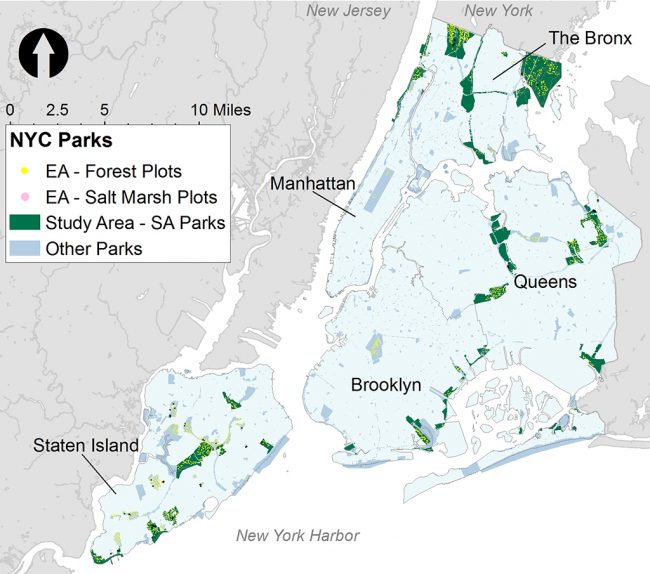
Study area for the social and ecological assessment | Map prepared by Michelle Johnson; data courtesy of Natural Areas Conservancy, NYC Parks, and US Forest Service
Though perhaps best known for its role in the Million Trees NYC initiative (991,000 have been planted so far), the Urban Field Station’s most recent major project manages to top that predecessor in ambition. A team of social scientists, ecologists, and Parks employees is now busy assessing the ecological health of New York City. “We’ve compiled the largest dataset that has ever been collected in an urban setting,” says Erika Svendsen, a social scientist with the Forest Service. To accomplish such a feat, the Forest Service and Parks Department joined forces with the Natural Areas Conservancy, which spun off from Parks in 2012. The privately funded organization raises money to support the conservation and restoration of New York City’s more than 10,000 acres of publicly owned natural habitat, in addition to what city government provides. It also fuels science-based management of the city’s remnant forests and wetlands, urban infrastructures that serve to promote resiliency, reduce inequality, and improve health for some 8.4 million city dwellers every day.
Over the past two summers, this urban health team has gleaned vitals from the treetops over City parkland, the worms in its soil, and the New Yorkers that amble between the two. “We looked at the same areas of parkland from both ecological and social perspectives,” says Sarah Charlop-Powers, the co-founder of Natural Areas Conservancy, which led the urban health assessment as its first project. Social scientists from the Forest Service canvassed all New York City parks over 400 acres and a sample of smaller parks citywide, where they collected over a thousand interviews; hundreds of photos of handmade fire pits, ad hoc seats, shrines, and empty spray cans; and tallies of how many people were hitting home runs versus napping under trees. (The popular Prospect and Central Parks were not included, as the parcels are managed by their own conservancies.) To round out a picture of holistic urban health, field biologists then measured the ecological state of parks’ natural areas — everything beyond the ball fields and manicured grass — by recording myriad variables in each park, from tree girth to the abundance of wildflowers.
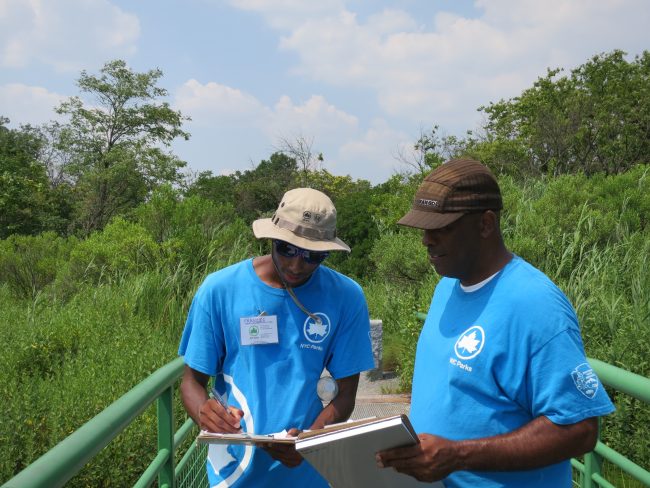
Jamaica Bay Restoration Corps field researchers collecting observational data | Photo courtesy of NYC Urban Field Station
In New York City, “you really can’t think about natural resources in isolation to how people use and value them,” says Lindsay Campbell, a human geographer who, along with Svendsen, led the social side of the assessment.
The team at the Urban Field Station is now hard at work poring over data from 1,600 interviews with park users. In parks’ forests and wetlands, social data collectors primarily reported the usual wilderness suspects like birders tracking summer tanagers and foragers on the hunt for garlic mustard seeds. They found fishermen in Alley Pond Park in Queens, where if you learn the best spots, you can actually catch your dinner. In one New York City forest, they met a small encampment of men who utilize the area as a shelter complete with monikers for surrounding stumps, benches, and other landmarks.
But thus far, some of the most compelling findings uncover how New Yorkers are extracting, for lack of better term, spiritual nourishment from these natural areas. Of all those surveyed, about a quarter of park users employ the city’s forests and wetlands as calming, meditative spaces, Svendsen says. In Brooklyn’s Canarsie Park, for example, they found an MTA bus driver resting his eyes on a patch of mixed trees, collecting his thoughts before an early morning shift. Other people use walks through parks’ oak-tulip trees to “flush the city out,” as one person said, echoing another’s deeper desire to “connect with their primordial existence.”
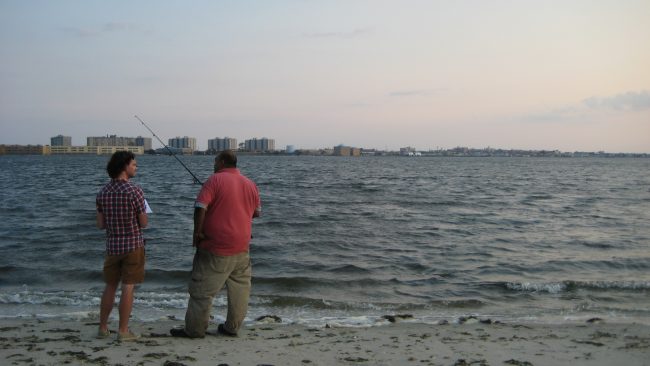
A field research supervisor interviews an angler on Jamaica Bay | Photo courtesy of NYC Urban Field Station
Documenting such non-recreational uses of parks’ natural areas wasn’t always as clear as tallying, for example, the number of visitors that come to a park each year. As Svendsen says, “the outcome wasn’t always a number.” In Queens’ freshwater and salt marsh habitats of Jamaica Bay, the local Hindu community employs the waterfront as a makeshift Ganges — lining the bay with candles, flowers, and pieces of fruit. Spiritual sightings were so frequent and telling that the Urban Field Station has decided to turn their data into a paper on the psychosocial spiritual benefits of parks to be published later this year.
This publication will fit nicely beside more than 40 years of psychology research on the boundless benefits of green space. Beginning with Forest Service-funded studies of the 1970s and now part of the field of environmental psychology — which explores how our surroundings affect our brains and lives — scientists are well aware that nature’s quiet, steady, and inherently fascinating qualities can reset the anxious mind. Just this summer, The New Yorker covered a recent study led by psychology professor Marc Berman and published in Scientific Reports. The finding: a correlation between the presence of ten extra trees on any city block and a one percent boost in how healthy its residents feel.
But in maintaining an urban forest that’s as healthy for the whole ecosystem as it is for the people within it, these can’t be just any ten trees. In some of New York’s past restoration efforts, says Charlop-Powers, almost half of the trees and shrubs planted were either the wrong species or size for their chosen habitat. “This was due to a lack of baseline data,” she says, something the urban health assessment now supplies.
Arriving better late than never, New York City’s new ecological baseline reveals that there are more than 800 unique plant species throughout the city — “a lot more biological diversity than we previously anticipated,” according to Charlop-Powers. During the assessment, biologists also noted that nearly 80 percent of New York City’s canopy remains native. Big trees like red and sugar maples and the warm-scented eastern red cedar “have grown here for millennia,” says plant ecologist Helen Forgione, who headed the ecological assessment. But as park size decreases, so do the number of natives. To compare: the sweeping 1,146-acre Van Cortlandt Park in the northern Bronx sported nearly 100 percent native canopy. Bronx Park, a 718-acre parcel along the Bronx River home to botanical gardens and the Bronx Zoo, revealed just half native canopy trees. Forgione attributes this finding to smaller parks’ greater proportion of city- and sun-exposed edges. Scrappy invasive vines thrive along these peripheries, she says, and quickly strangle out the native saplings. “The bigger the forest, the more interior you have, and the less edge” — as a forest shrinks, the more vulnerable its trees are to this so-called “edge effect.”
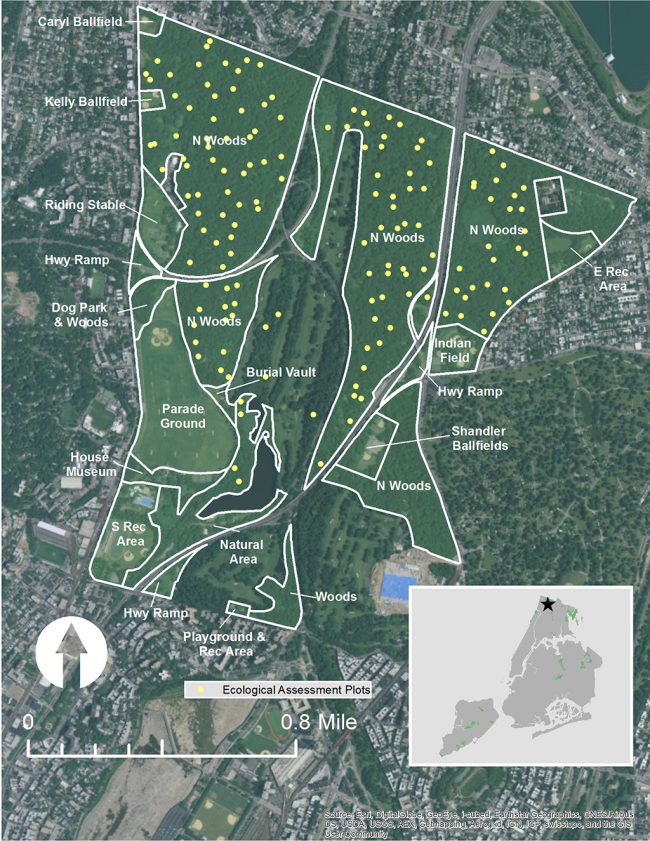
Social assessment zones in Van Cortlandt Park in the Bronx, overlaid with ecological assessment plots | Map prepared by Michelle Johnson; data courtesy of Natural Areas Conservancy, NYC Parks, and US Forest Service
In surveyed natural areas large and small, soil quality alone largely determined the health of the forest above it. Highly native Van Cortlandt Park sustains a rich leaf layer at ground level. Without this slowly rotting stack of leaf litter to hold in moisture and nutrients, Forgione says, some seeds will never muster the energy to sprout. Van Cortlandt’s healthy decaying layer, like its native cover, has its many acres to thank. Constant footsteps trampling over the same swaths of parkland can quickly erode and degrade it; in a big parcel this is less likely to happen. Additionally, Van Cortlandt doesn’t have many non-native earthworms. Though prized in America’s agricultural soils, these descendants of dropped fishing bait and hitchhikers on exotic plants churn forest leaf litter too quickly, fashioning dirt less fit to nourish the forest’s next generation.
The fewer earthworms, the better soil, and where there is good soil, there’s more flora. “We definitely noticed that in places with really rich forest floors of leaf litter, there was much more herbaceous layer,” Forgione says. Though New York City is known for its rich, multi-layered forests compared to those in neighboring New Jersey and Connecticut, the assessment’s ecologists observed signs that this primacy could flip. “White-tailed deer are a real emerging threat for our forests here,” the same culprits, Forgione says, of the barren understory in neighboring states. Once as rare as a “Bigfoot sighting,” deer have been paddling from New Jersey across the Arthur Kill to Staten Island, where the population has jumped from 24 to almost 800 in six years, according to the Staten Island Advance in 2014. This population boom has nibbled Staten Island’s undergrowth to near extinction.
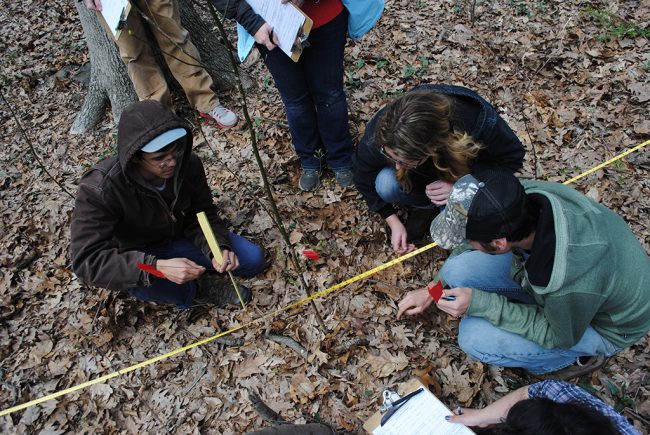
Researchers measure leaf litter depth in Van Cortlandt Park | Photo courtesy of Natural Areas Conservancy
Disappearing seedlings, saplings, shrubs, and wildflowers directly affect the many New Yorkers who find refuge and leisure within the depths of the city’s parks. “People tend to change their behavior when they come into wild spaces,” Svendsen says. Not everyone plays basketball or baseball: “In a way, the wild areas are the parks’ most common spaces.”
Accordingly, the health assessment revealed “a lot more diversity of human use of natural areas than we anticipated,” Charlop-Powers says. And in one of the assessment’s more surprising discoveries, data shows that people aren’t just traveling distances to reach world-renowned parcels like Central Park. In 2013, the social assessment discovered that 37 percent of that summer’s 600 study participants were actually traveling more than 20 blocks to visit the marshy parks of Jamaica Bay. “It’s a shift to think of these more remote parks” as main attractors, says Charlop-Powers.
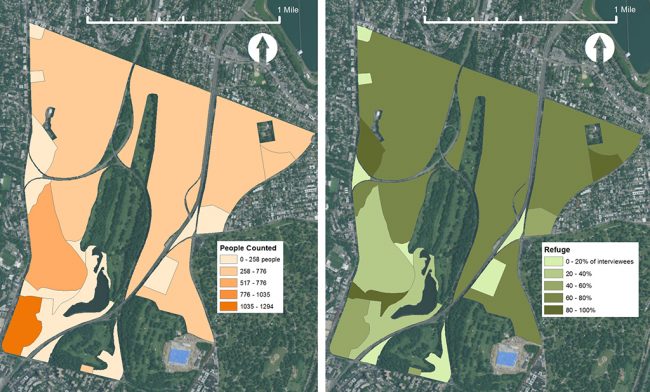
Map showing number of people observed in Van Cortlandt Park over three summertime visits, by zone (L) and map showing percentage of respondents interviewed who said they use the park because it is a refuge (R) | Map prepared by Michelle Johnson, data courtesy of US Forest Service
Mirroring the Parks Department’s age-old philosophy of balancing enjoyment of nature with preserving its delicate systems, Charlop-Powers hopes that the new assessment’s social-cum-ecological scope will facilitate New Yorkers’ favorite urban wilderness activities in an environmentally sensitive way. By carving out new hiking trails, she says, Parks can ensure that nature lovers get their daily dose while they avoid trampling over new native saplings and blooms.
This approach isn’t exclusive to New York. Across the nation, “there’s a leaning toward managing land from this biological as well as social perspective,” Charlop-Powers says — “it’s definitely a field that we will see on the rise.” The City of Seattle, for one, is ten years into a 20-year initiative to restore its urban forests, marking a clear commitment with a line-item allocation in the city’s annual budget. Findings from the social and ecological assessment of New York’s natural areas will help the Natural Areas Conservancy develop something similar: “a forest management plan for all of New York City” that would span 20 years and 7,000 acres, she says. Such a comprehensive approach is still to come, but the Conservancy is already employing the study’s insights in those parks that may not fall among the most popular flagships but are no less loved by many New Yorkers.
To restore the salt marsh and grassland ecosystems and preserve the native asters and cordgrass of Brooklyn’s Marine Park — the borough’s biggest — the Conservancy has already proposed a new trail system that will meander through over a hundred acres. In Bronx River Forest, another trail loop currently under construction will cover 20 acres to keep park users from harming natives like box elders and mulberry trees. But it’s not all for the plants. By protecting these natural areas, the Conservancy is also sustaining a critical sanctuary for people — the New Yorkers who find refuge in parkland less flaunted, more tranquil, and little wilder, too.
The views expressed here are those of the authors only and do not reflect the position of The Architectural League of New York.